HOME | ABOUT US | MEDIA KIT | CONTACT US | INQUIRE
HOME | ABOUT US | MEDIA KIT | CONTACT US | INQUIRE
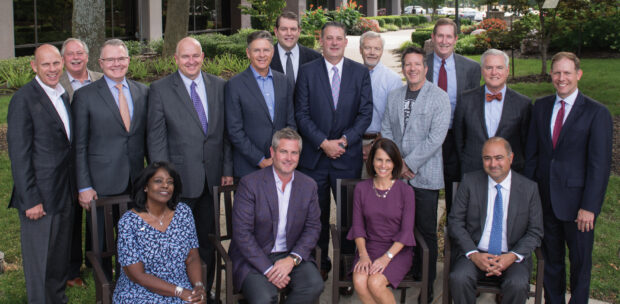
Business leadership in the Kansas City region is getting older—and, paradoxically, younger. As retirement beckons for many business leaders, often with iconic names in civic and philanthropic roles, new names are being etched in the leadership roles of area companies. That implies profound change not just in the ways companies are being run, but in the nature of business-to-business relationships, and with the way companies are engaging in non-profit and civic causes.

Michael Kulp cautioned that the Kansas City region needs to avoid a sense of complacency.
Those effects had the full attention of high profile executives who gathered in the meeting room of KBP Foods’ Corporate Woods offices September 16 for the 2019 Ingram’s 250 General Assembly, a meeting designed exclusively for the leaders of key organizations in the region. With the host firm’s CEO, Michael Kulp, helping direct the two-hour discussion, they explored the impact of sweeping changes in leadership, but also offered perspectives on key issues facing the regional business community: the emerging opportunity to build consensus for a Downtown sports stadium, factors that drive growth (or might hinder it) for the region, the ever-present matters of inner-city violence, work-force training and more.
A Fundamental Challenge
It came up several times during the assembly: Kansas City as a region is flush with opportunities on the scale it confronted in the 1970s, when it executed a series of high-profile infrastructure projects. Those added new vibrancy to a city caught in a post-war spiral: a new airport, innovative sports stadiums that spawned an entire industry, a new convention center/sports arena.
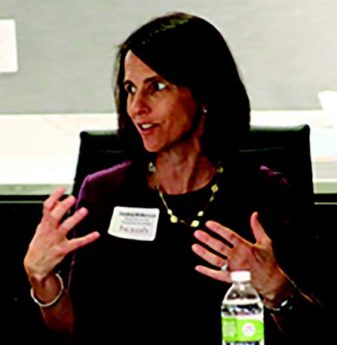
Debbie Wilkerson believes new business leaders are bringing a different energy level to the region.
Today, there is talk of building a Downtown baseball stadium, work is under way to transform KCI into a single-terminal configuration, blueprints are being drawn for a Downtown streetcar extension that now has a financing mechanism. For those at the table, the questions come down to details about execution.
And the execution will matter, because it defines a region that too often looks to other communities for yardstick comparisons. We’d be far better served, said U.S. Engineering’s Tyler Nottberg, by looking inward: Things happening in Chicago and Dallas are things we should be aware of, he said, “but Kansas City does Kansas City really well,” he said, and should put its focus on leveraging its unique strengths.
Among those, said Debbie Wilkerson of the Greater Kansas City Community Foundation, were its assets in entrepreneurship and in life sciences broadly. “There’s an energy here,” she said, and the concept of Kansas City Kind is a real one.

Kansas City, said Tyler Nottberg, needs to focus less on what other cities are doing, and more on what it does well.
Bringing fresh perspectives to the group were Dale Klose, regional president of national banking power PNC Bank, and Mandeep Johar, CFO for educational-content provider Ascend Learning. Both are new to the market over the past couple of years, hailing from communities with greater challenges.
“I think Kansas City has been growing tremendously compared to Cleveland,” said Klose, and that growth is one reason why the Pittsburgh-based PNC Bank has entered this market as part a strategic expansion to the west. Johar concurred, having witnessed broad stagnation back in Connecticut, where he worked for 24 years for General Electric before joining Ascend Learning.
Pat Stueve, a native of this area with a highly successful litigation law firm, cited a key advantage for the region in the work-force arena: “We’ve been able to get really good Midwestern talent to come back to Kansas City” after exploring options elsewhere, he said, and that talent has helped the firm succeed. But a challenge would be ensuring that the city offers enough to keep that talent in place, as well as attract newcomers.
Anyone who wants to compare Kansas City to bigger economic engines in Dallas and Chicago should look more closely at what life in those communities is really like, several attendees said. “The growth there is overwhelming,” said Rich Smith of Henderson Engineers. He also appreciates the sense of hometown pride on display here—T-shirts can tell you a bit about their wearer, and lots of them can tell you about the communities where those people live. He doesn’t see that same sartorial display in other cities. He was also glad to see that the region was moving forward after a generation of civic stagnation that set in after the buildout of the 1970s, especially Downtown, where The Quaff was about the only social scene operating when he arrived in Kansas City.
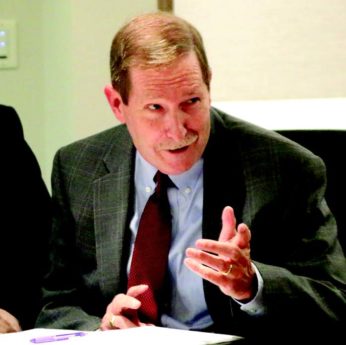
A Downtown stadium, cautioned Mark Radetic, wouldn’t necessarily be the comprehensive draw some envision.
But a historical perspective is an important one. Mark Radetic of MarksNelson, a native of St. Louis, has spent his working career in Kansas City, and sees a “vast difference” between this community today and when he arrived, despite some of the silos that linger today, especially those related to the state-line division.
“But I don’t think we necessarily want to become a Dallas or an LA. What we’re trying to become is exactly what we need to be.”
His compatriot in accounting, BKD’s Abe Cole, also has been working here since the early 1980s, and has watched as Downtown has come back to life before his eyes. Now, he says, “about 80 percent of our hires are new college graduates” at the firm, and the thriving Downtown scene plays into their calculus when assessing job possibilities. The work at KCI, “while I don’t think it’s a magic bullet,” is going to push the region forward, he said.
Greg Klein of Inland Truck Parts Co. checked off a list of attributes that are regional strengths: affordable housing, to be sure, but also the ease of moving around the city on its ample highway lane miles. With locations at some of those comparison cities, he said, “all I hear is about how bad the traffic is.”
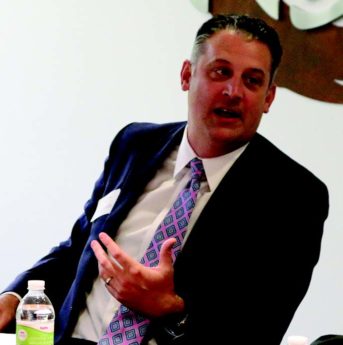
Abe Cole says a thriving Downtown has been a hiring asset with BKD’s recruitment of college graduates.
Transportation infrastructure, he said could be an area for future growth: “I think about the next highway loop around the region, especially in the south,” he said.
Despite the attributes, the area is not without challenges. Foremost among those for Lenora Payne of Technology Group Solutions is “finding good, talented people” to drive continued expansion of her fast-growth IT services firm.
Darren Taylor of GEHA concurred, ratcheting up the standard descriptions of the labor market by calling it “that war for talent.” That plays out in different ways depending on one’s sector. And for host KBP Foods, as well as Wilbert Funeral Services, the ample supply of jobs available presents considerable hiring challenges in retail and blue-collar settings. And finding talent in those roles that don’t require college degrees, said Greg Klein, continues to be a challenge for many companies in the region, something that should engage efforts to promote those career pathways, too.
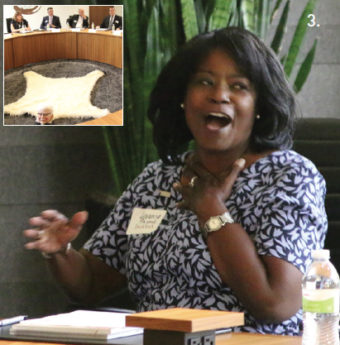
Lenora Payne started with a thoughtful assessment of the region’s work force, but was startled midway though at the sight of an unusual floor covering.
The rug in question included the head of KFC’s Col. Sanders—a promotion by host KBP Foods.
While the region has a good, solid work force to draw from, “turnover has been killing us,” said Wilbert’s president/CEO, Dennis Welzenbach. “It’s been as much as 30 percent a year.” The company spent four years grooming one executive for a key leadership position, but had to go back to square one when another employer—from a different sector—offered an additional $15,000 in compensation. He’s seen the talent-attraction dynamic work first-hand with the 2017 sale of Wilbert, which will roll out over four years. The designated CEO, coming in from Connecticut, can spend $600,000 here to buy a home that would cost $1.5 million on the East Coast, and the ready access to spaces to stable his wife’s horse is a huge plus.
When it comes to comparing ourselves to faster-growing cities, said Marc McEver of Olathe Ford Lincoln, it’s not just about infrastructure, arts and affordable housing prices. “One big difference is winter,” he said. “We’ve got winter.” But we also have some sales-tax rates that are pushing the threshold for what the retail sector can tolerate, he said.
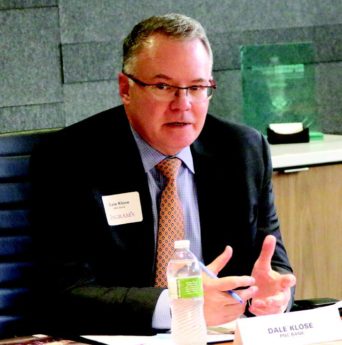
Kansas City’s strong growth, said Dale Klose, was a main driver of PNC Bank’s decision to expand here.
Two things about this region stand out for Bernstein-Rein’s Steve Bernstein: “One is obvious, and it’s the divisions we have in Kansas City” with both the state line dividing east from west, the Missouri River presenting a harder barrier to overcome between north and south, and some lingering racial division. “Less obvious,” he said, “as Midwesterners we’re too humble.” Even with a lot of great things going on in this region, he said, “we just don’t brag about it.”
The Next Big Thing
The community has been abuzz for several weeks about the Glass family’s agreement to sell the Kansas City Royals to a group of investors led by hometown energy executive, John Sherman. Almost in tandem with the rise of a new Downtown a decade ago, there has been occasional speculation about what a baseball stadium could mean for that transformation.
“It was a fascinating decision to put the stadiums where they sit,” said Rich Smith, “and the design of those stadiums spawned a whole industry.”
The Arrowhead Stadium half of the twin-stadium complex, in particular, poses a challenge in determining where to go from here, several attendees said. The unintended consequences of changing a cultural hallmark of football Sundays—perhaps the nations’ best example of fan tailgating—should be considered, they said.
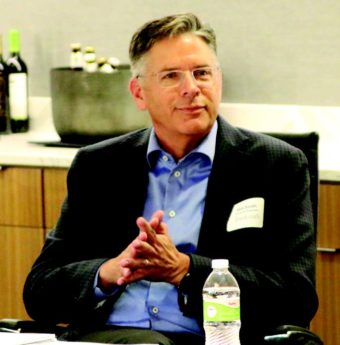
Rich Smith said the innovation behind the Truman Sports Complex spawned an entire new design discipline.
Part of the civic challenge is that both stadium, within just a decade or so, have undergone massive upgrades. Kauffman Stadium completed a $260 million facelift in 2009—about the same, in inflation-adjusted dollars, as the original project in the early ’70s. A similar renovation that wrapped up in 2010 at Arrowhead cost $375 million, and another $11.5 million upgrade was proposed just this spring. Which begs the question: Have we done too good of a job upgrading the Truman Sports Complex to risk major changes now?
“A ballpark Downtown will have repercussions for what the Chiefs are going to do,” said Tyler Nottberg, and that’s a consideration. But now is precisely the time to be discussing any changes, he said. The long run-up times for design and construction, combined with the existing lease’s expiration in 12 years, don’t leave much time for community deliberations, he said. “You’ve got to back up that timeline when those leases expire to figure out how to make that decision as a community in a non-pressure-cooker situation. If you wait 2-3-4 years, you’re going to have a pretty acrimonious debate.”
Others concurred: If a change of this magnitude is to be made, civic support must be marshaled now. That will be tough to build for those who enjoy what the current setup has to offer.
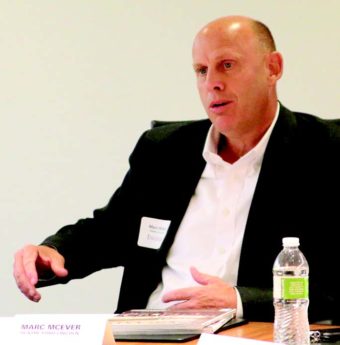
One of the factors that has to be addressed in discussions about Downtown sporting venues, said Marc McEver, is the impact on parking dynamic that is already challenging.
Marc McEver said he would be concerned about whether Downtown could accommodate thousands of vehicles on game days, considering how limited parking is now. “Traffic is a big deal, and if it’s any kind of event with a serious draw, it’s a problem Downtown,” he said.
Even with the wide-open lots at the current stadiums, one doesn’t make a quick exit from that congestion, he said.
“That’s what I struggle with,” said Pat Stueve. He said he can get from his home near Loose Park to Lot J at the complex in as little as 15 minutes. Doing anything that alters that, for him, makes it “a tough call.”
Then, too, is the financing question. Are Jackson County taxpayers alone to be on the hook for an amenity with broad regional, even multi-state appeal? A bistate taxing district, like the one that financed the renovation of Union Station a generation ago, could be a possibility, but “bistate complicates things more on Downtown,” said Steve Bernstein. “If you look at patterns for who is attending games, that’s one of those issues where we get back to the state-line discussion, and can we take that out of the discussion?” said Tyler Nottberg. “I wonder if Topeka and Jeff City will allow it to be taken out.”
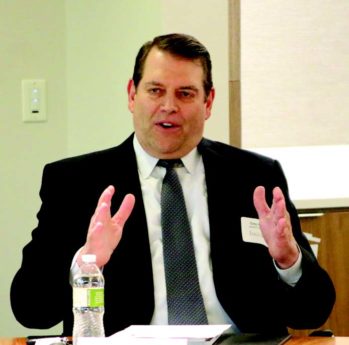
Ample highway infrastructure today, said Greg Klein, might need to be supplemented with additional highway lane miles.
Mark Radetic advised caution, based on the St. Louis experience with its most recent stadium project. “There has to be a lot of forethought on this. It is not a silver bullet … I do have acquaintances there who ran restaurants and they’re now out of business. It’s not necessarily a matter of if you build it, everyone will come and everyone will be successful.”
Another looming opportunity, by chance, also involves sporting life: Kansas City’s bid to serve as a host city for the 2026 FIFA World Cup soccer tournament. By some economic projections, a host city in that mix could reap an economic benefit several times more than what cities have enjoyed by hosting Super Bowls. That, though immediately engenders questions about infrastructure. Do we have a transportation system that can get them to, presumably, Arrowhead Stadium and other venues while they’re in the region? And do we have the hotel space to accommodate thousands of out-of-town visitors and foreign nationals?
“Transportation would be difficult for outsiders,” Steve Bernstein observed.
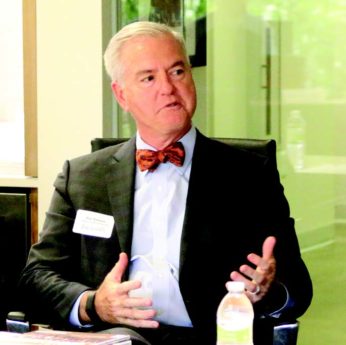
Midwestern talent returning to Kansas City has helped drive success at Pat Stueve’s law firm.
But within those challenges might lie some unique opportunities; the long-held vision for a rolling roof at the sports complex could again come up for discussion. “You could build a narrative around that for events we can’t attract right now, like the Final Four,” said Pat Stueve.
As a city, something will have to be done to ensure arrangements for a massive visitor infusion. As Abe Cole noted, before “they come and camp here.”
Outside of pro sports, the region is poised to see explosive growth in its animal-health corridor and life-sciences communities—the $2 billion National Bio and Agro-defense Facility in Manhattan is slated to start its first operations in a couple of years. By the time its fully functional, the high-level research to defend the nation’s livestock and food chain from biological or terror threats is expected to spin off a thriving start-up sector.

Steve Bernstein cited the state line, the Missouri River
and Kansas City’s excessive lack of boastfulness as factors that inhibit growth.
“There’s a great deal of optimism in Manhattan,” said Tyler Nottberg, noting the increase in companies locating there ahead of the NBAF opening. But it will focus attention on the area the way the American Royal has emphasized the region’s enormous economic tie to agribusiness, he said.
It is mildly ironic, Rich Smith pointed out, for a city that struggled to shed a cowtown image for more than a century has been rebranding itself as a global center of excellence for animal health. But that will bring benefits, he said, just as the huge growth of the engineering and design footprint here has done, putting Kansas City in every conversation about such concentrations of talent.
New Leadership Emerging
It’s indisputable that the wave of retirements at key organizations is changing the makeup of the region’s leadership ranks. But is that change fraught with risk, or have organizations here successfully planned for that transition? It will play out for at least another decade with the back half of the Baby Boom generation—but to what end?
“It’s something we’ve got to think about as a community,” said Mark Radetic.
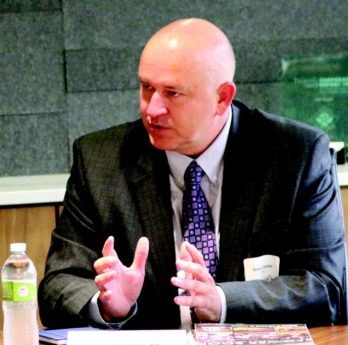
With an infusion of younger workers, said Darren Taylor, GEHA’s older workers must change, too.
One way the region has been anticipating that change, said Greg Klein, was with a series of corporate moves to employee ownership through ESOP transactions. Some of the most prominent companies in the region are now employee owned—JE Dunn, Garney and McCownGordon in the construction sector, Burns & McDonnell and Black & Veatch in engineering/design space come immediately to mind. And all have been recognized for best-practices as employers.
“The concept works tremendously,” said Greg Klein, speaking of Inland Truck Parts’ experience, “but it won’t fix a broken company.”
The large concentration of such companies in this region, said Abe Cole, is coming as “a lot of new, great leaders are stepping up” in business.
That will pay dividends not just for smooth business transition, participants said, but for the philanthropic causes that many retiring leaders have supported in recent decades, and created an infrastructure for engagement that will thrive through the changes.
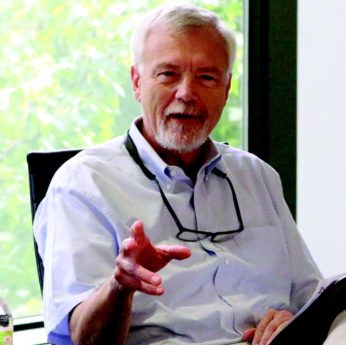
Crippling turnover, said Dennis Welzenbach, is a serious concern, especially in sectors that
required blue-collar workers.
“From a philanthropic standpoint, a lot of these new leaders started in grade school with their projects,” said Mark Radetic, pointing to an educational trend that hadn’t yet taken root during his youth.
“We have a 35-year-old mayor” in Quinton Lucas, Pat Stueve noted, and he emerged from the recent mayoral election in Kansas City from among a plurality of newer, younger faces seeking that leadership mantle through the primary season.
As for businesses themselves, Marc McEver surmised that his 38 years with Olathe Ford Lincoln wouldn’t be precisely replicated with successive generations. “The way we win in business has changed a lot in that time, and the way we will win in the future won’t be the same.”
Part of that cultural shift with new leadership is that technology has allowed them to work at a much higher level, earlier in their careers, than their counterparts of the past, said Abe Cole.
“What I love about the next generation,” said Debbie Wilkerson, “is what it’s doing to push organizations philanthropically.” People entering the work force today are choosing their first career pathways with corporate social engagement holding a high value in their selection metrics. “They’re redefining the whole purpose of a company,” Wilkerson said.
That’s playing out with corporate missions, too, Darren Taylor said. GEHA, long a traditional insurer in the payments/processing mode, has shifted its mission to place a high priority on wellness and the overall health-care experience of its national client base, he said.
A downside of technology in use today, said Mark Radetic, is that it is enabling something of a disconnect when remote workers are not living in the communities where their companies are located.
That’s why “it’s important to make civic engagement a part of corporate culture” no matter where employees work, said Abe Cole. Even if someone working from a remote location for your firm can’t join other employees at a charity fundraiser, they can do volunteer work or provide board service where they do live—and in doing so, extend the reach of a company’s brand in philanthropic terms.
As drivers of that culture, said Michael Kulp, “we make big mistakes when the allocation of dollars is the work” that companies do. Signing checks isn’t enough, he said; creating a corporate philanthropic strategy today requires holding non-profits accountable for success. “If they haven’t made a difference, they shouldn’t be at the table” seeking assistance, he said.
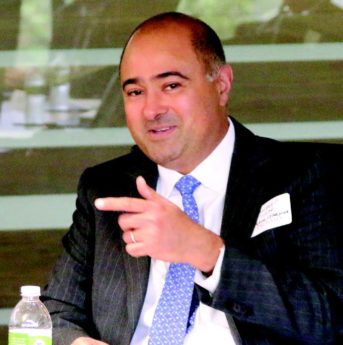
Mandeep Johar said he was impressed by the strong growth in this market, compared to his previous post in Connecticut.
In that regard, any employee who provides time and talent for board work should do so with a mindset of pursuing success metrics and “challenge themselves to be the CEO of that board for a day.”
Dale Klose noted that with 600 PNC Bank employees in KC, not all are fit for board service, but all can engage at a volunteer level. And the bank encourages that with a remarkable commitment of 40 hours of paid time off for each employee. Across an organization with half a million employees, that’s a substantial in-kind donation, but PNC supplements that with checks that those employees can take back to non-profits after meeting their annual service allocation. “It gets them engaged in the community,” he said.
KC Going Forward
As the broader community settles on civic goals—or tries to—Michael Kulp cautioned against the kinds of complacency that put Kansas City into a long funk a generation ago. “At times, things here move very slowly,” he said. “The streetcar took a long time. The airport took a really long time.”
Anyone who hasn’t been to Denver in the past five years, he said, wouldn’t recognize it today, he said. But just as important “what makes this city special today can go away.”